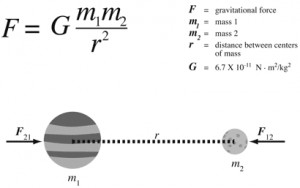On trying, and on the odds of success
A great many years ago, when I was studying physics as an undergraduate, and also coaxing a girlfriend to come visit for the weekend (honesty compels me to admit that she wasn’t really a girlfriend but rather was a girl I hoped—unreasonably, as it turns out—to win over as a girlfriend), I calculated the approximate gravitational attraction between her body and mine, first with her at her own campus a couple hundred miles away and then at the blessed moment when we would be in close proximity to each other.
Schoolwork compelled me to do such calculations anyway. This exercise was simply an effort to make the practice relevant.
According to my figures, the second value was somewhat greater than the first. That is, the force of attraction between us did increase a bit when we were together, but not so much that you’d notice. I mean the numbers were infinitesimally small.
Calculations really weren’t necessary to arrive at that conclusion. The girl did come to visit, but only I think to confirm that the suspicions she already held about me were correct. Despite rudimentary stirrings of romanticism, I was a tedious geek.
That old misadventure came to mind today, prompted by a silly poem addressed to an insignificant grain of sand (… Is this the life that you had planned? That there’d be jillions just like you? …). It started me thinking about numbers outside normal experience (the size of a grain of sand, the number of such grains in the world, etc.) and from there (inevitably) back toward a subject closer to my heart, the combinational possibilities in mixing and matching genetic information from one generation to the next and specifically how in the blazes my son Joseph ended up with a developmental disability that even now remains unexplained.
When Joseph was a baby, a neurologist told me to accept his condition because, as he put it, “it just happened.” I hated the ease with which a man of science could so easily shrug off a young patient as a victim of random chance, without even attempting to understand, much less treat, the problem. So I rejected what he said. In those days, Judy and I thought it was likely a case of birth trauma—brain injury perhaps due to prolonged labor and vacuum delivery. We were embarking on a years-long home campaign to help him overcome that injury, and of course knowing what we were up against could have affected the choices we made, and our chances of success.
Not that those chances were defined any more accurately than the problem itself. Geeks presume that expressing something in numbers is a way of enhancing control over whether we’ll get the outcome we want, be it a new girlfriend or a healthy child. In this case, however, there was no handy formula for quantifying those odds.
Over time it became apparent that they must have been very long odds–maybe one in whatever number of universes would be required, based on random chance, for this one to turn out as it has. And I might as well confess to having no better grasp of figures like that than anybody else. (I was always impressed with the image of a hundred bottles of beer on the wall.)
But I suspect that really knowing what such numbers mean would result in inaction, and absolute zero chance of success. This is where people’s romantic impulse has value—the thing that prompts us to throw ourselves into impossible causes. After all, some folks do win the lottery. Some families working very hard with a disabled child do achieve life-changing breakthroughs. Heck, even in our abysmal ignorance, Judy and I won victories with Joseph.
And for those who don’t get the prize (we didn’t, certainly not to the extent we wanted), well, there’s comfort in knowing that it’s not such a bad thing to expend yourself on a noble cause.
Still, it can only help to have a good solid grasp of what you’re up against. And that’s why I continue the pursuit, even at this late date. Next up for Joseph is a relatively new test called whole exome sequencing.
And then “someday“…
This blog post also appears in The San Diego Reader.
Tags:
